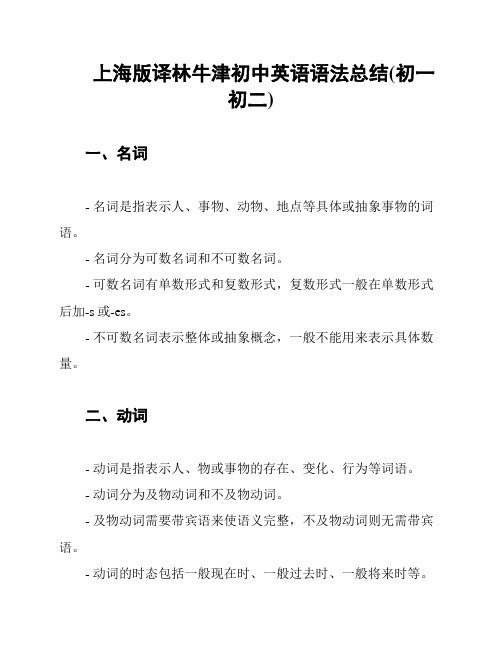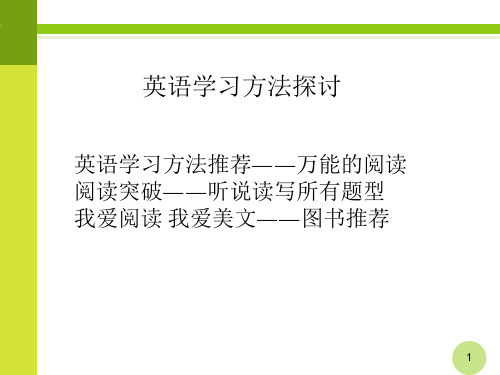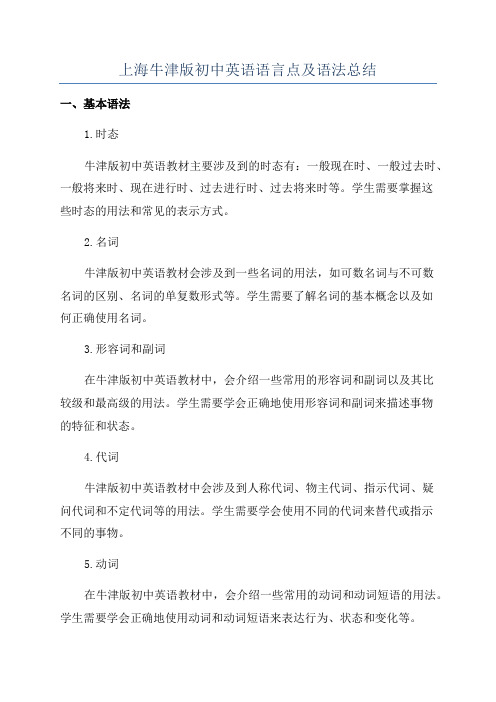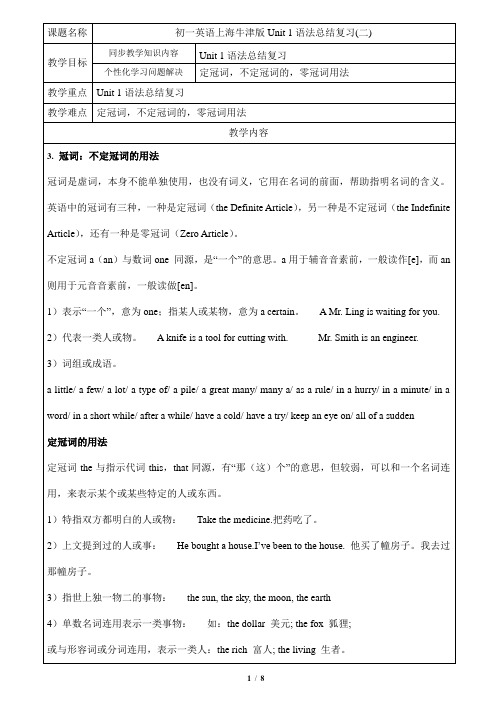上海市初一年级牛津版英语语法总结
上海版译林牛津初中英语语法总结(初一初二)

上海版译林牛津初中英语语法总结(初一初二)一、名词- 名词是指表示人、事物、动物、地点等具体或抽象事物的词语。
- 名词分为可数名词和不可数名词。
- 可数名词有单数形式和复数形式,复数形式一般在单数形式后加-s或-es。
- 不可数名词表示整体或抽象概念,一般不能用来表示具体数量。
二、动词- 动词是指表示人、物或事物的存在、变化、行为等词语。
- 动词分为及物动词和不及物动词。
- 及物动词需要带宾语来使语义完整,不及物动词则无需带宾语。
- 动词的时态包括一般现在时、一般过去时、一般将来时等。
三、形容词- 形容词是指表示人或事物的特征、性质或状态的词语。
- 形容词一般位于名词之前修饰名词。
- 形容词可以比较级和最高级,用来表示程度或者比较。
四、副词- 副词是指修饰动词、形容词、副词等的词语。
- 副词用来表示时间、地点、方式、程度等。
五、代词- 代词是指用来代替名词的词语。
- 代词分为人称代词、物主代词、指示代词、疑问代词、不定代词等。
六、介词- 介词一般用来表示人或物在时间、地点、方式、原因等方面的关系并引导介词短语。
七、连词- 连词是指连接词语、词组或句子的词语。
- 连词可以分为并列连词、选择连词、从属连词。
八、冠词- 冠词是指用在名词之前起限定作用的词语。
- 冠词分为"不定冠词(a/an)"和"定冠词(the)"。
九、句子结构- 句子由主语、谓语和宾语构成。
- 主语是句子中的中心成分,主要是指句子说话的主体。
- 谓语是句子的谓语动词和宾语常常一起构成的。
- 宾语是句子的动作的承受者或者受事者。
十、时态- 英语动词有时态的变化。
- 一般现在时表示经常或惯性的动作。
- 一般过去时表示过去发生的动作。
- 一般将来时表示将来会发生的动作。
十一、语法符号- 语法符号包括句号、问号、感叹号等。
它们用来标点句子的结束、疑问、感叹等意义。
- 句号(.)用来句子的正常结束。
- 问号(?)用在直接疑问句的句末。
沪教牛津版七年级U1知识点总结重点句型词汇

14பைடு நூலகம்
问题四: Why not plan a special Mother’s Day for her? 为什么不为她筹划一个特别的母亲节呢? Why not意思为“为何不……”, 提出自己的建议或征求对方的意见,后接动词原型。 句型为: Why not do sth. Why don’t you do sth. 句型同义 提出建议的句型 Shall we …? ; Let’s …; What about doing sth.
20
在周末,她的父母经常鼓励她阅读或者去参加一些户外活动。
On weekends her parents often encourage her to read or take part in some outdoor activities.
With the encouragement of one of her teachers, she began to write. 在她的一位老师的鼓励下,她开始写作。 (中考真题) Jessica’s parents always encourage her ____ out her opinions. A. speak B. speaking C. to speak D. will speak
spend 花费,花费时间或金钱。 I spend five yuan on/buying the pair of gloves. I paid five yuan for the pair of gloves. The pair of gloves cost me five yuan. spend 主语是人,句型 spend time/money on sth./in doing sth. pay 主语是人,常用句型: pay…for… cost 主语是物,常用句型:sth. cost sb some money
上海牛津版初中英语语言点及语法总结

上海牛津版初中英语语言点及语法总结一、基本语法1.时态牛津版初中英语教材主要涉及到的时态有:一般现在时、一般过去时、一般将来时、现在进行时、过去进行时、过去将来时等。
学生需要掌握这些时态的用法和常见的表示方式。
2.名词牛津版初中英语教材会涉及到一些名词的用法,如可数名词与不可数名词的区别、名词的单复数形式等。
学生需要了解名词的基本概念以及如何正确使用名词。
3.形容词和副词在牛津版初中英语教材中,会介绍一些常用的形容词和副词以及其比较级和最高级的用法。
学生需要学会正确地使用形容词和副词来描述事物的特征和状态。
4.代词牛津版初中英语教材中会涉及到人称代词、物主代词、指示代词、疑问代词和不定代词等的用法。
学生需要学会使用不同的代词来替代或指示不同的事物。
5.动词在牛津版初中英语教材中,会介绍一些常用的动词和动词短语的用法。
学生需要学会正确地使用动词和动词短语来表达行为、状态和变化等。
6.句子结构牛津版初中英语教材中会涉及到一些句子的结构,如肯定句、否定句、一般疑问句和特殊疑问句等的构成方式和用法。
学生需要学会正确地构造各种不同类型的句子。
7.从句牛津版初中英语教材中会介绍一些常用的从句的用法,如宾语从句、定语从句和状语从句等。
学生需要学会理解从句的作用和用法,并正确地构造各种不同类型的从句。
二、语言点1.日常交际用语牛津版初中英语教材中注重培养学生的交际能力,会提供一些日常生活中常用的交际用语。
学生需要学会运用这些用语与他人进行正常的日常交流。
2.生活常识和文化知识牛津版初中英语教材中会涉及到一些生活常识和文化知识,如国家、城市、节日、传统习俗等。
学生需要了解这些常识和知识,扩大自己的视野和知识面。
3.阅读理解和听力牛津版初中英语教材中提供了一些阅读理解和听力训练的材料,帮助学生提高自己的阅读理解和听力技能。
学生需要通过阅读和听力训练,培养自己的语言理解和应用能力。
4.写作技巧牛津版初中英语教材中会介绍一些写作技巧,如如何写日记、如何写情书、如何写旅行日志等。
初一英语上海牛津版Unit 1语法总结复习(二)

7)在三餐、球类运动和娱乐运动的名称前,不加冠词;如:have breakfast, play chess
8)当两个或两个以上名词并用时,常省去冠词;
I can’t write without pen or pencil.没有钢笔和铅笔,我就写不了字。
A. /, /B. the, theC. /, the
What / How about going to Paris?为什么不去巴黎呢?
5.写电子邮件的格式要点:
收信人To xx,寄信人from xx:Dear后用逗号,结尾部分:要加上yours, love等,再换行写名。
注意:考试中不能出现真实的个人信息。
冠词专项练习
Ⅰ在下列名词前填入a或an.
1month 2clinic 3apple 4carnation
Ⅲ按要求填入the,不需要的填写“/”.
17 Beijing iscapital of China.
18boys often playtable tennis after school. They seldom playtable tennis.
19 she can’t go toschool today. She stays inbed.
3)词组或成语。
a little/ a few/ a lot/ a type of/ a pile/ a great many/ many a/ as a rule/ in a hurry/ in a minute/ in a word/ in a short while/ after a while/ have a cold/ have a try/ keep an eye on/ all of a sudden
沪教牛津版英语七年级上册知识点总结

Unit 11来自be from=come from2和...住在一起live with...3靠近.. close to=near4艺术老师an Art teacher5姐姐an elder sister6乘车上学go to school by bus / take a bus to school7 擅长be good at doing sth. = do well in doing sth.8交朋友make friends with...9来自世界各地的朋友people from all over the world =around10 发邮件给某人email sb.11 离...很远far away from....12 .....的意思是the meaning of . (13)在某人的空余时间in one’s free time14 …的答案是the answer to …15 一个德国女孩a German girl16 在互联网上on the Internet17 放风筝fly a kite / fly kites18 收到某人来信hear from sb= receive / get a letter from19 最美好祝愿best wishes20 许多朋友a lot of / lots of / many friends21 洗澡take a bath22 想做某事would like to = want to … 23 你多大了?What’s your age?/ How old are you?24 完成complete=finish4. work as + 职位名称作为…而工作6. walk to school=go to school on foot 走路去上学7. be keen on (doing) sth=be interested in 对….感兴趣8. enjoy (doing) sth= like doing sth 喜欢做某事9. reply to sb回信给某人11. a photo of 一张…的图片13. speak Chinese 说中文15. in the middle 在中间20. write to sb写信给某人,注意pay attention to 以…开始begin with 参考书reference book语法1:特殊疑问词及其引导的特殊疑问句(what, where, when, how, why, which)What refers to things.对事物提问(什么)(可以用来询问职业) Where refers to places.对地点提问(在哪里)Who refers to persons.对人提问(谁)How refers to ways.对年龄提问(多大年纪,几岁)How old refers to ages.对某人或情况提问(怎么样)When refers to times.对时间提问(何时)what time (只能用来问具体几点钟)Why refers to reasons.对原因提问(为什么)which refers to kinds (种类).对事物或人称提问(哪一个,哪一位)How many refers numbers.对数量提问(多少)How old ...多大年纪How often ... 多经常,多久一次How far... 多远How long ... 多长时间How soon 多快,多语法2:不定冠词的用法不定冠词有a和an两个,仅用在单数可数名词前。
新版上海牛津版七年级(上册)语法

新版上海牛津版七年级上册语法一、知识点(一)特殊疑问词特殊疑问句:以疑问代词what, who, whose, which或疑问副词when, where, why, how 等放在句首提问的句子,叫特殊疑问句。
答句必须针对问句中的疑问词来回答,疑问词分为疑问代词和疑问副词。
一、特殊疑问词<一> 疑问代词who/whom/whose/what/which1. who, whom, whose 只能指人who常作主语或宾语;whom作宾语,可用who替代;whose常作定语或表语。
eg: Who taught you math last year? <主语>Whom did you see? <宾语>Whose father works in Shenzhen? <定语>2.what用来询问物或数量,用来询问人时涉及人的职业,身份或外貌。
如:What would you like to eat today? 你今天想吃什么?What is your mother ? 你妈妈是干什么的?3.which用来询问人或物,一般有特定的选择范围。
如:Which is your sister of the two girls? 那两个姑娘中哪个是你姐姐?<二>疑问副词常用的疑问副词有:where, when, why, how以及how引伸的一些疑问词组,如:how much <many>, how long, how old, how far, how often, how soon等。
他们在句中通常作状语,可表时间,方式,原因等。
如:When will you come back? 你什么时候回来?Where did you put your mobile phone? 你把手机放哪Why are you late? 你为什么迟到?How long did you stay in Beijing? 你在北京呆了多久?二、不定冠词1. 不定冠词是a/an,一般放在名词之前。
牛津上海版初一英语知识点总结

牛津上海版初一英语知识点总结第一篇:牛津上海版初一英语知识点总结牛津上海版初一英语知识点总结牛津上海版英语词组及短语(中英对照版)1.在左上角2.在右上角3.下棋4.笔友5.和某人住在一起6.担任……工作7.在学校8.在中间9.最美好的祝愿10.戴着眼镜的那个女孩子11.在右边12.在左边13.在学校的足球队里14.一年级,二班15.女子篮球队16.男子接力比赛17.在世界上18.全世界19.在……旁边20.对……友好21.热衷于……22.擅长于……23.语文24.数学25.地理26.生物27.历史28.化学UNIT1—4at the top-left corner at the top-right corner play chesspenfriendlive with somebobywork as at schoolin the middlebest wishesthe girl in glasseson the righton the lefton the school football teamClass Two,Grade Onegirls’ basketball teamboys’ relay racein the world all over the worldnext to / besidebe friendly to be keen onbe good atChinesemathsgeographybiologyhistorychemistry29.体育P.E.30.音乐music 31.政治politics 32.物理physics 33.少先队员Young Pioneer 34.小学pramay schol 35.初中middle school/junior high school 36.高中senior middle school 37.大学university/ college 38.做运动do exercise 39.做眼保健操do eye exercises 40.做早操do morning exercises 41.照相take pictures/photos 42.喜欢做某事like/enjoy doing sth.43.想要做……want to do sth./ would like to do sth./ 44.注意……pay attention to 45.写下,记录下write down 46.从左边/右边from the left/right 47.收到某人的来信hear from sb.;get/receive a lettere from sb.48.锻炼身体do sports 49.持续一段时间last for 50.一两个小时one hour or two/ one or tow hours 51.在街道上in the street 52.在……的开始at the beginning of 53.在……的结尾at the end of 54.保安guard 55.建筑工人construction worker 56.牙科医生dentist 57.会计师accountant 58.去游泳go swimming 59.去海边go to the sea 60.去滑雪go skiing 61.去滑冰go skating 62.去购物go shopping 63.去观光go sightseeing 64.去远足go hiking 65.去跑步go running 66.去慢跑go jogging 67.去跳舞do dancing 68.去航行go sailing 69.去约会70.到达(4种表达方法)arrive in/at;reach;get to 71.花费时间(金钱)的表达方法: sb.spend…on sth./sb.spend...(in)doing sth./ sb.pay…for stth./ sth.cost sb.some money/ it takes sb….to do sth.72.主管be in charge of 73.照顾look after/take care of 74.独生子女the only child 75.开会have a meeting 76.迟到be late for 77.除……之外except/ except for 78.从周一到周五from Monday to Friday/ on weekdays 79.刷牙brush the teeth 80.洗脸wash face 81.追赶(某人)go after sb./ run after sb.82.及时in time 83.按时on time 84.盯着、凝视stare at 85.跑开run away 86.下车get off(the bus)… 87.上车get on(the bus 88.捡起pick up 89.思考think about 90.匆忙in a hurry 91.从……冲出来strom out of/ rush out of 92.熬夜stay up late 93.生某人的气be angry with sb 94.在……的一边on the side of 95.在……的另一边on the other side of 96.等候wait for 97.拿出hold out/ take out 98.跌倒fall over 99.戴着手铐in handcuffs 100.四处走走go/walk around 101.找出,查明find out 102.说谎tell a lie 103.立刻in a flash/ at once/ right away/immediately 104.将来in the future 105.在意、关心care about 106.查询(生词)look up 107.四处看look around 108.有一个选择have a choice 109.正在那个时候at that moment 110.毫无疑问地without question 111.走到跟前、走近come over 112.改变注意change one’s mind 113.尽可能快as soon as possible 114.有时间玩乐have time for fun 115.在……顶部on the top of… 116.或……或……either……or…… 117.既不……也不……neither……nor…… 118.不仅仅……而且……not oly… but also… 119.将……与……比较(将……比作) compare with/ compare toUnit 5---Unit6重点词组Unit 5 1.灭绝;消失die out 2.因……而死die of 3.得知,获悉learn about 4.和……一样the same as 5.因…而著名be famous for 6.同时at the same time 7.以……为基础be based on 8.充满……be full of 9.根据according to 10.依(某人)之见in one’s opinion 11.因为;由于because of 12.超过more than/ over 13.同类的 of this kind 14.做(某事)有一些困难have difficulty with sth./ have difficult in doing sth./ find it difficult to do something.15.全世界范围内all over the world 16.其余的;剩下的the rest of…… 17.既不…也不…neither ……nor…… 18.对……有用处be useful for 19.一等奖the first prize 20.害怕……be a fraid of…… 21.至多有up to 22.生育give birth to…… 23.也;还as well as 24.……方面的专家expert on…… 25.完全地,彻底地competelyUnit6一、词组1.能够be able to / can 2.成为现实;实现come true 3.从现在起from now on 4.到达arrive at/in;get to………;reach…… 5.生病get sick 6.一会儿in a moment/minute 7.和平地in peace 8.破碎地in pieces 9.在太空in space 10.将来in the future 11.降落于……land on 12.看起来像look like 13.部分part of 14.而不是15.耗尽;用完not …but…run out ofUnit 7--8词组:1.从现在起from now on 2.躺下lie down 3.入睡fall asleep 4.从(某地)逃走5.太……以致于……6.过了一会儿7.逃离8.对准;瞄准9.熄灭10.广播、公布11.听起来象12.从……出来13.告诉……实情14.生气15.事实上16.开……的玩笑17.给……提供某物18.过着幸福的生活19.过着艰苦的生活20.过去常常做(某事)21.过去常常不做(某事)22.数以亿计23.除……之外,还……按时24.全世界25.给某人拍照26.例如27.在过去28.广交朋友29.在周末30.赶快31.立刻escape fromtoo…to…;so…that…moments laterbe out of……aim at…go uoutput outsound likecome out oftell the truthbe angry withsb./ get angry in factpaly jokes onprovide……with…live a happy lifelive a hard lifeused to do sth.didn’t use to do sth.billiions ofas well asall over the worldtake photo for …for examplein the pastmake a lot ofat the weekendhurry upin a second/at once/right away/immediately32.考虑think of 33.中国出口品交易Chinese Export Commodities Fair第二篇:上海牛津英语4AM1知识点总结.M1U1 Meeting new people 1.词汇:classmate 同学schoolmate 校友deskmate 同桌friend朋友 meet 遇见people人们eleven 十一twelve十二thirteen 十三fourteen 十四fifteen 十五sixteen 十六seventeen 十七eighteen 十八nineteen 十九twenty二十student number 学号sit 坐skip跳绳live居住near在……附近year年well好mask 面具2.词组:my classmate 我的同学go to the park 去公园ride a bicycle骑自行车 skip a rope 跳绳live near the school住在学校附近walk to school走路去学校play basketball 打篮球like reading喜欢阅读years old 岁—Nice to meet you!很高兴遇到你!—Nice to meet you,too.我也很高兴遇到你!See you!再见!3.语法:形容词性物主代词his,her,your,my,its,their,our 形容词性物主代词(所有格后必须加名词。
沪教牛津版初中英语七下教材短语句型知识点汇总

沪教牛津版初中英语七下教材短语句型知识点汇总Unit 1 People around us读:读三个学生关于他们身边人物的文章。
听:一个女孩跟地奶奶谈论她们的亲戚的事情。
语法:学会如何使用定冠词the。
说:学会部分音素的发音。
谈论你喜欢的人。
写:写一篇关于你所爱的人的短文。
A.短语归纳1.XXX跟某人谈论某事2.buy sth。
for sb.(=buy sb。
sth.)为某人买物3.give sb。
sth。
(=give sth。
to sb.)给某人某物4.as well除……之外;也5.take care of照顾;照料6.two years ago两年前7.tell XXX讲笑话8.make fun of取笑9.be good at=do well in擅长10.be full of充溢,装满11.lots of许多12.make friends with与……交朋友13.save…from (doing)拯救……免于……14.from…to…从……到……15.be XXX对某事要求严格16.look like看起来像17.go to work上班18.all day and all night通宵达旦19.XXX在某方面帮助某人20.hard work辛苦的工作21.the number of……的数量22.first name名23.middle name中间名st name姓25.XXX sb跟或人说某事.26.in the world在天下上27.study hard努力研究28.play table XXX打乒乓球29.give sb。
support给或人撑持30.write down写下31.look after照顾32.give sb。
a lot of hope给某人很多希望33.in the sky在空中st night昨天晚上35.a visit to……之旅36.play a computer game玩电脑游戏初一下册37.play the guitar弹吉他38.play XXX打篮球39.the man in the purple suit穿紫色西装的人40.have to不得不41.every weekend每一个周末42.XXX…带或人去……B.句型归结1.It XXX time to do sth.破费工夫做某事2.make sb。
- 1、下载文档前请自行甄别文档内容的完整性,平台不提供额外的编辑、内容补充、找答案等附加服务。
- 2、"仅部分预览"的文档,不可在线预览部分如存在完整性等问题,可反馈申请退款(可完整预览的文档不适用该条件!)。
- 3、如文档侵犯您的权益,请联系客服反馈,我们会尽快为您处理(人工客服工作时间:9:00-18:30)。
时态讲解一、一般现在时主要用于:1 、表示经常性或习惯性动作。
e.g. It seldom snows here.2 、表示现在的特征或状态。
e.g. He is always ready to help others.3 、普遍真理。
e.g. Action speaks louder than words.4 、剧情图片介绍,背景说明,动作解说。
e.g. (Tom enters the room and sits at the table)Doctor :What's your trouble, young man?Tom :I've caught a cold, doctor.5 、时间、条件、让步、方式状语从句表将要发生的动作时。
e.g. Tomorrow we shall go for an outing unless it rains. 与这种时态连用的时间状语常有:always, often, never, seldom, usually, on ce, a week, now等。
二、一般过去时主要用于:1 、表示过去某个时间发生的动作或情况 (包括习惯性的动作或状态)e.g. When did you read the novel? She often came to help us in those days.2 、谈到过去的情况时e.g. I didn't know you were so busy.3 、谈到已死人的情况时e.g. Lei Feng was a great communist fighter. 与这个时态连用的时间状语常有:yesterday, last night, the other day, two months ago, in 1985, then, just now, whe n, after, as soon as引导的时间状语从句,表示主句动作开始的时间。
三、现在完成时主要用于:1 、表示到现在为止这一时期中发生的动作或情况,即多次动作的总和。
e.g. We have learnt four English songs this month. How many times have you read the novel?For many days we haven't seen each other.2 、表示对现在有影响的某一已发生的动作。
e.g. The delegation has lef代表团已经走了(说明现在不在这里)Look, what you have done.看你干的事。
与这一时态连用的时间状语有:already, yet, just, ever, never, by now, so far, rece ntly, by the end of this mon th, sin ce, fo短语,连词since 弓丨导的时间状语从句。
一般过去时与现在完成时的区别:一般过去时:重在说明动作在过去发生时的具体情况(时间、地点、方式、对象、细节等)。
现在完成时:只提起已发生的动作(事实)及其影响,不说明动作发生时的具体情况。
cf. Have you had your lunch? What did you have for lunch?I have ever been to the Great Wall, and I went there last summer with my father.注:现在完成时表达的动作常具有反复性,故下面一句是错的:Have you see n the six thirty's n ews program® 改为:Did you see the six thirty's news program?四、现在完成进行时主要用于:表示过去开始的某一动作一直持续到现在,以至延伸到将来,它强调动作延续时间之长久。
e.g. I've been writi ng an article我一直在写一篇文章。
(还在写)cf. I've written an article. 我写了一篇文章。
(已写完)It has bee n raining these dayS这些天一直在下雨。
五、过去完成时1 、过去完成时是一个相对时态,表示过去的过去,只有在两个过去发生的动作相比较时才可显示出来。
e.g. As soon as we got to the station, the train had left.注:主从句表达的动作紧接时,即两动作发生的时间没有明显时间上的悬殊或空档时,主从句都可用一般过去时。
e.g. Where did your brother study before he joined the army?2 、过去完成时可表示截止过去某一时间动作的总或动作的结束。
e.g. By the end of last month. We had reviewed four books By eight o'clock, he had finished his homework.与这个时态连用的时间状语常有:by 1985, by eight o'clock, by then, bythe end of last mon th, by the time whe n, whe n, as soon as, befor 等连词引导的时间状语从句,表示主句动作结束的时间。
六、现在进行时主要用于:1 、表示现在或现阶段正在进行的动作。
e.g. Listen, someoneiscrying. What are you doing these days?2 、代替一般现在时,表示经常性动作或状态,而含有某种感情色彩。
e.g. How are you feeli ng toda y你今天感觉怎样?(显得亲切)He is doi ng well in his lesso ns 他的功课很好。
(赞扬)You are always boast ing你老爱吹牛。
(厌烦)3、动词go, come, leave, arriv等表将要发生的动作时。
e.g. They are leaving for Shanghai.与这种时态连用的时间状语常有:now, these days, recently, this week 等。
七、过去进行时主要用于:表示过去某个时刻或阶段正在进行的动作。
e.g. At that time she was working in a PLA unit. 那时她在解放军某部工作。
What were you doing this time yesterday? 与这个时态连用的时间状语常用:at nine o'clock, this time last night, these days, at that time等。
用when 引导的时间状语从句表示主句的动作正在进行的时间。
e.g. When he came in, I was reading a newspaper.注:1 、while 引导时间状语从句叙述过去的动作时,从句常用过去进行时。
e.g. I read a magazine while I was waiting for the bus.2 、when 用作并列连词,意为“这时”,连接两分句时,第一句多用过去进行时。
e.g. I was reading a newspaper when he came in. 一般过去时与过去进行时的区别:一般过去时:强调过去某一时间开始或完成的动作。
过去进行时:强调过去某一时间正在进行的动作。
试区别下面两句:We were buildi ng a reservoir last wi nte去年冬天我们在修建一座水库。
(可能尚未建成)We built a reservoir last win ter去年冬天我们修建了一座水库。
(已经建成)八、一般将来时主要用于:表示将要发生的动作或情况e.g. Tom will have a bike of his own.与这个时态连用的时间状语常用:tonight, tomorrow, the day after tomorrow, n ext week, in three hours, two days late等。
一般将来时态与其它结构表将来情况的区别:一般将来时态:主要从时间的角度表将要发生的动作或情况。
be going to结构:①表(主观上)打算或准备做某事时。
②表有发生某事的预兆时。
e.g. They are going to have a competition with us in studies. It is going to rain.据以上区别,故下面一句是错的:I am going to be eightee n years old n ext yea应改为:I shall be eightee n years old next year.be about to do sth 结构:意为“刚要做某事”、“马上要做某事”强调时间之紧迫性。
e.g. We are about to discuss this problem.们将马上讨论这个问题。
be to do sth 结构:表示按计划、安排、规定将实施某事或表示注定会发生某事。
e.g. When is the train to leave. All these things are to be answered for. 及物动词与不及物动词英语中按动词后可否直接跟宾语,可把动词分成及物动词与和及物动词。
1. 及物动词:字典里词后标有vt. 的就是及物动词。
及物动词后必须跟有动作的对象(即宾语),可直接跟宾语。
see 看见(vt.) + 宾语I can see a boy.2. 不及物动词:字典里词后标有vi. 的就是不及物动词。
不及物动词后不能直接跟有动作的对象(即宾语)。
若要跟宾语,必须先在其后添加上某个介词,如to,of ,at后方可跟上宾语。
具体每个动词后究竟加什么介词就得背动词短语了,如listen to,look at…3. 宾语(动作的对象):是名词或代词,或相当于名词的词或短语(如动名词)。
其它词不看作动作的对象呢。
4.举例:“看”(1)see看见(vt.) + 宾语lean see a boy.(2)look 看(vi.) x宾语(即不能直接加宾语).Look! She is singing. Look carefully!注意:carefully是副词,不是名词,故不作宾语哟)(3) ................ l ook at 看.+ 宾语Look at me carefully! (me是代词,作宾语了)连系动词连系动词本身有一定的词义,但不能独立作谓语,必须与表语一起构成谓语。
